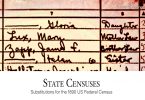The 1890 US federal census is gone. Destroyed in a fire in the 1930s, only fragments of it remain, and the vast majority of genealogical researchers are not going to find their relatives in those few, precious pieces. This leaves a gap in the genealogical record in the United States of twenty years, from 1880 to 1900. What can you use to fill in that unfortunately large gap? The good news is that you have quite a few options. More than one record source exists to help you with your 1890 census issues. Vital records are one of them.
Most genealogists will have used vital records. They are invaluable for proving the dates of birth, death, and marriage of ancestors, as well as their places of birth, their full names, and the names of their parents (often, but not always). They are some of the most basic genealogical tools, and in a sense, are foundational ones. The proper use of vital records has assisted many new genealogists in getting their proverbial feet off the ground. Believe it or not, they can also be helpful in getting past the gap in the records left by the 1890 US federal census.
Vital records for ancestors who were born died, or married in the early 1900s can give clues to the names of their parents—parents you might not otherwise be able to trace because the 1890 census is missing. With the names of the parents in hand, you can go to even earlier censuses to find out more about the family, thus jumping the 1890 cap entirely.
You can also use vital records to find the birth dates and full names of people born in the 1890s. Most states were starting to require official vital records to be filed for births by the 1890s (though some states didn’t start until later). If you have a first and last name, you can order the record, and get the exact birth date and full name. Most states will do a multi-year search for you with just a name and a range of years. Just bear in mind you will usually have to pay an extra fee for the search. It is worth it, though, when it produces results.
The 1900 and 1910 US federal censuses tell you how many children a woman has had, and how many of them are still living at the time of the census. If you have the mother’s name, you can ask the state’s department of vital statistics to do a search of the entire decade of the 1890s for children with that mother (you will need to know the city or town they lived in to be sure you get the right person’s children). Have them look for any children born to that woman. When you get the birth certificates in the mail, you may have discovered some missing children who would have been on the 1890 census.






